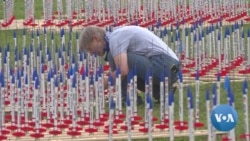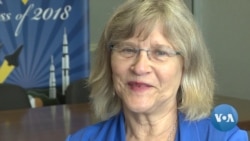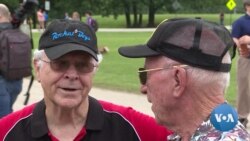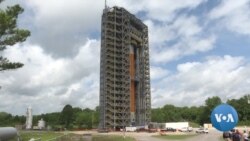HUNTSVILLE, ALABAMA - It was only fitting that on the 50th anniversary of the 1969 rocket launch that ultimately landed a man on the moon, the “Rocket City” of the United States would attempt to set a rocket record.
“We are launching 5000 bottle rockets to break a Guinness World Record,” explained Randall Robinson. He is the Director of Training at SpaceCamp, an immersive space and science experience geared towards youth, many of whom came to watch this special record launch attempt on the campus that SpaceCamp shares with the U.S. Space and Rocket Center in Huntsville.
“Us wanting to break this record is signifying, and putting, Huntsville back on the map, for the importance that it played in the Apollo program,” he told VOA, as a countdown clock ticked away the minutes to zero hour for the launch.
In the race to the moon in the 1960s, the development of a large rocket that could thrust spacecraft beyond earth’s atmosphere became a critical element that could make or break the Apollo moon program.
That critical element – the Saturn V rocket - was developed in Huntsville under the leadership of scientist Wernher von Braun at NASA’s Marshall Space Flight Center.
No doubt
In an exclusive interview with Voice of America, Von Braun’s daughter Margrit said her father and his team never doubted their ability to deliver a powerful rocket design that would work.
“We just knew it was going to work. We just grew up with this presumption of success and I think this is how the rocket team behaved.”
Margrit von Braun was among honored guests and thousands of spectators who gathered in Huntsville for the 50th anniversary celebrations that paid tribute to the many that made the lofty goal of landing a man on the moon a reality.
The launch of the first astronauts to set foot on the moon in 1969 was a mission Margrit von Braun experienced firsthand, alongside her father, considered today the “father of rocket science.”
“It was my first launch,” she fondly recalled. “There really aren’t words to describe it. That’s what most people say. The noise and the power of the engine and seeing how slowly the rocket moves before it clears the tower is something I’ll never forget.”
Future astronaut?
“It’s a moment in history, a moment when we landed on the moon, and launched a rocket, and it’s important,” said 12-year-old Lillian Duran, who had the distinct honor of pressing the launch button that sent nearly five thousand bottle rockets soaring into the cloudy Alabama sky.
Although she wasn’t alive the last time humans set foot on the moon, she’s hoping this year’s anniversary celebrations of the first lunar visit 50 years ago sparks further interest in the space program for a new generation.
“We want to go further and explore,” she told VOA.
Launchpad for the future
It’s an age-old desire that fueled the imaginations, and eventual careers, of many seasoned NASA astronauts and engineers, including Homer Hickam, author of the popular book “Rocket Boys” which became the source material for the movie October Sky.
“It’s something for us to commemorate, and also it kind of helps us I think give us a launchpad for the future,” Hickam explained to VOA.
While officials at the U.S. Space and Rocket Center wait for the smoke to clear for certification of their record rocket launch attempt from Guinness, not far away the future of manned space flight is taking shape at NASA’s Marshall Space Flight Center, where new rockets and technology are being tested for future missions to the moon, and eventually to Mars.















